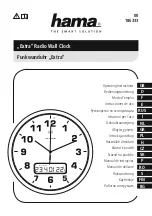
Note
Testing is only allowed without standard radio protocol. Please set "Radio protocol" to "None"
in Radio Settings before using this feature.
8.7.5. Antenna detection
Antenna detection is a tool (Detector) for Tx antenna and transmission circuits failure detection. The
“Radio TX or antenna degraded” Event is triggered in case the Detector detects a problem.
Detector needs to be calibrated first to operate correctly:
Calibrate
button initiates the calibration process. Following steps need to be done:
1. Set the Radio protocol to ‘None’. The Calibrate button can be pressed afterwards.
2. Disconnect the Tx antenna. It is recommended to disconnect the antenna cable as far from the radio
unit (closer to the antenna) as possible – to get better detection sensitivity.
3. Connect the antenna. The antenna should not be disconnected any more after the calibration is
finished – to ensure proper Detector sensitivity. If the antenna needs to be disconnected for a
reason, it is recommended to repeat the calibration process afterwards.
Calibration limits:
• Calibration is valid for the given values of Tx frequency and RF Power. If those values need to be
changed, it is necessary to re-calibrate the Detector after such change.
• The calibrated parameters are specific for the given radio unit and antenna connection. This is the
reason, why the calibration parameters cannot be backed up for the eventual transfer to a backup
unit. In case the radio unit needs to be replaced, the Detector must be re-calibrated.
Reset
button initiates the Detector status reset. Such a reset is needed when the unit is operated as
a Hot-standby unit (see below) and the Detector caused the Hot-standby units’ switchover: the passive
(repaired) station needs to be reset after the repair.
8.7.5.1. Hot-standby operation
The Detector Event can be used as one of the triggers for the Hot-standby units’ switchover. There are
several conditions for the Hot-standby operation:
• Both Hot-standby units need to be calibrated separately
• In case of shared Tx antenna, each unit must be calibrated as active – in order to have the antenna
connected.
• In case of separated Tx antennas, it is possible to run the calibration both on active and passive unit
independently. Unit repair or replacement does not interrupt the user data traffic. The calibration
process (of the eventually replaced station) causes a short (up to 10 seconds) interference of the
active station.
• The Detector needs to be reset after the passive station repair (see above).
RipEX2 Radio modem & Router – © RACOM s.r.o.
192
Diagnostics
Содержание RipEX2
Страница 2: ......
Страница 12: ...Fig 1 2 RipEX2 bench testing RipEX2 Radio modem Router RACOM s r o 12 Quick guide...
Страница 14: ...2 1 Dimensions Fig 2 1 RipEX2 dimensions RipEX2 Radio modem Router RACOM s r o 14 Product...
Страница 138: ...RipEX2 Radio modem Router RACOM s r o 138 Settings...
Страница 225: ...Fig 10 1 Sample document 1 3 225 RACOM s r o RipEX2 Radio modem Router Safety regulations warranty...
Страница 226: ...Fig 10 2 Sample document 2 3 RipEX2 Radio modem Router RACOM s r o 226 Safety regulations warranty...
Страница 227: ...Fig 10 3 Sample document 3 3 227 RACOM s r o RipEX2 Radio modem Router Safety regulations warranty...
Страница 234: ...Fig 10 7 Grant for RipEX2 1A RipEX2 Radio modem Router RACOM s r o 234 Safety regulations warranty...
Страница 235: ...Fig 10 8 TCB Grant for RipEX2 4A 235 RACOM s r o RipEX2 Radio modem Router Safety regulations warranty...
Страница 236: ...Fig 10 9 TCB authorization RipEX2 Radio modem Router RACOM s r o 236 Safety regulations warranty...
Страница 237: ...Fig 10 10 FCB certificate for RipEX2 1A 237 RACOM s r o RipEX2 Radio modem Router Safety regulations warranty...
















































